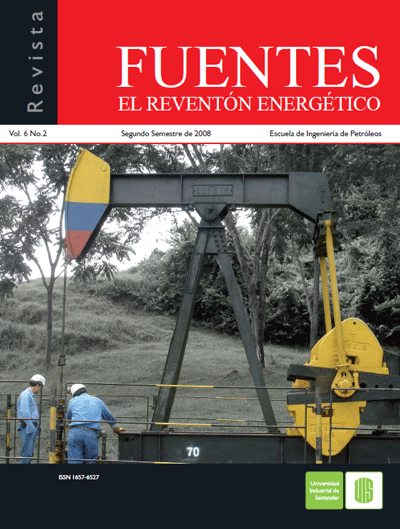EVALUACIÓN DE LA VELOCIDAD DE CORROSIÓN DE UN ACERO AISI-SAE 1020 EN UN SISTEMA MULTIFÁSICO NaCl 3% -ACEITE MINERAL-CO2-H2S POR MEDIO DE UN SIMULADOR DE FLUJO
Publicado 2008-11-28
Cómo citar
Resumen
RESUMEN
La corrosión en sistemas multifásicos proviene de la interacción electroquímica de las especies corrosivas (CO2, H2S, crudo -fase oleica-) etc., disueltas en un medio acuoso con el acero, llevando a la oxidación metálica y la subsiguiente pérdida de metal. Esta situación es significativamente aumentada por los efectos relacionados con el flujo en sistemas multifásicos. La corrosión por CO2 ha sido extensamente estudiada, pero pocos trabajos han direccionado los efectos del CO2 con pequeñas cantidades de H2S. En este estudio se evaluó la velocidad de corrosión en un sistema multifásico compuesto por una salmuera saturada con CO2, H2S y aceite mineral en contacto con un acero al carbono AISI-SAE 1020 a diferentes condiciones de temperatura y velocidad, utilizando un simulador de flujo tipo Loop. Se determinaron los efectos de la velocidad de flujo, la temperatura y la relación aceite/ agua por medio de las técnicas electroquímicas Tafel y espectroscopía de impedancia electroquímica.
Palabras clave: Loop, flujo multifásico, Tafel, Espectroscopía de impedancia electroquímica
ABSTRACT
Corrosion in multiphase systems comes from the electrochemical interaction of the corrosive species (CO2, H2S, oil (oil phase) etc.), dissolved in aqueous environments one with the steel, taking to the metallic oxidation and the subsequent metal loss, this situation is significantly increased by the effects related with the flow in multiphase systems. The CO2 corrosion rate has been widely studied, but few works they have addressed the effects of the CO2 with small quantities of H2S.This study evaluated the corrosion rate in a multiphase system consisting of a brine saturated with CO2, H2S and mineral oil in contact with a carbon steel AISI-SAE 1020 to different conditions of temperature and velocity, using a simulator of flow rate Loop. We determined the effects of flow rate, temperature and the oil / water by electrochemical techniques Tafel and electrochemical impedance spectroscopy.
Keywords: Loop, multiphase flow, electrochemical impedance spectroscopy, Tafel.
